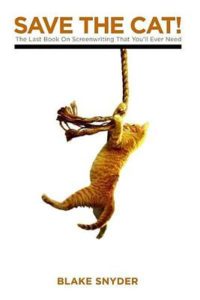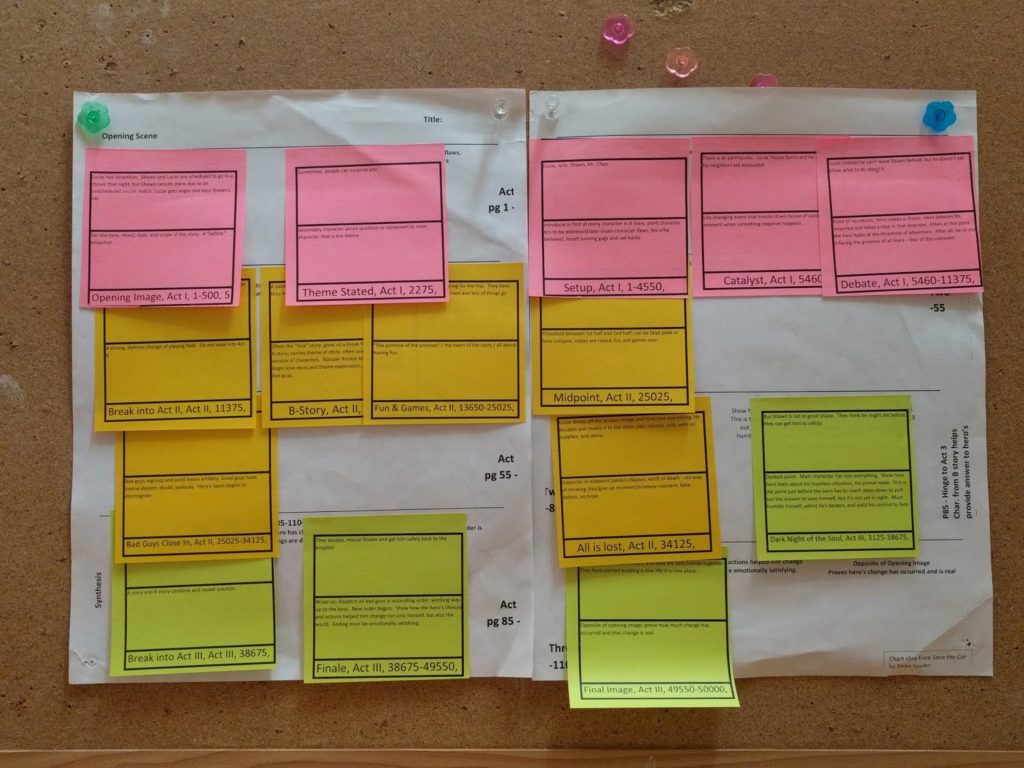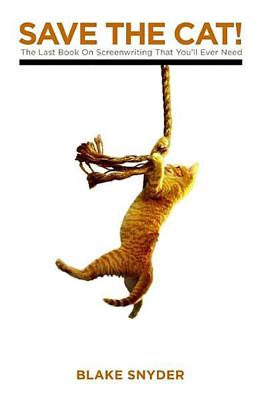craft review by Jen Jobart
You might think that Save the Cat! is just a book about screenwriting, given that its subtitle is “The Last Book On Screenwriting You’ll Ever Need.”
 Many movies do use the beat sheet, created by Blake Snyder. It’s especially easy to see in Disney and Pixar films, as well as other kids’ movies. Zootopia, for example, is a model Save the Cat! movie: it has a strong theme, shows good character growth for all of the characters, not just the main character, and hits all of the plot points Snyder describes.
Many movies do use the beat sheet, created by Blake Snyder. It’s especially easy to see in Disney and Pixar films, as well as other kids’ movies. Zootopia, for example, is a model Save the Cat! movie: it has a strong theme, shows good character growth for all of the characters, not just the main character, and hits all of the plot points Snyder describes.
But the beat sheet isn’t just for movies. Many, if not most, books use it too. The Middle Grade Lunch Break group read Save the Cat!, and for several months afterwards, as an exercise, we applied the Blake Snyder Beat Sheet to the middle grade novels that we were reading. And I’ll be darned if all of the beats weren’t there in just about every novel we read. One good example was Seer of Shadows by Avi. It is a meandering and surprising historical ghost story, so different than many Disney movies, yet the beats are all there, just the same.
For me, reading Save the Cat! was an epiphany. It helped me understand for the first time that story has a universal structure. It unlocked the magic formula. I hope it helps you, too.
The Blake Snyder Beat Sheet
The masterpiece of Save the Cat! is the Blake Snyder Beat Sheet. It converted me from a pantser to a plotter, and it’s no coincidence that the first book I actually finished was conceived using the beat sheet.
Blake Snyder’s beat sheet has 15 beats. He describes them in a clear way that made sense to me as a fledgling fiction writer. And once I knew what the beats were and started paying attention, I realized that they’re universal. Blake Snyder didn’t invent them, he just noticed them.
I’m convinced that natural story writers–those mythical people who have stories running through their veins and who can sit down and write a final draft with no outline–architect their stories this way instinctively. Me? I need to have the beats spelled out for me, and I spend a lot of time structuring my story before I ever get started writing.
Here’s what works for me: I have the beats all laid out on a couple of sheets of paper that I have pinned to a bulletin board. I use red, yellow, and green post-it notes for the different acts–that way my outline color-matches the Scrivener Project Target tracker. I keep the bulletin board in front of me as I’m writing so that I can remind myself to stay on track as I write. Often I will stray from my original outline, but by having the outline there in front of me, when I do make a change, I do it deliberately, and I think about how the change will affect all the other plot points before I do a lot of work that will lead me to a dead end. That was a lesson I learned the hard way. I didn’t finish the first two books I tried to write because their plots just fizzled out at the midpoint. Mapping the entire book out a la Blake Snyder before x starting the first draft was, for me, the key to actually finishing a book for the first time.

Jen’s Post-It Note Beat Sheet Strategy
There are lots of different ways to describe the beats of a story, and, really, the only right way is the one that works for you. Christopher Vogler’s classic The Writer’s Journey presents a story structure that has a lot of overlap with Save the Cat! Martha Alderson, in her book The Plot Whisperer, also presents a story structure that has some overlap. And then there’s The Snowflake Method, which is an entirely different approach that many people swear by.
The Blake Snyder Beat Sheet is structured pretty tightly. He gives actual page counts where each of the beats should fall based on a 110 page screenplay script. I’ve heard people say that with novels, it doesn’t matter whether the beats fall in exactly the right place, or even in the same order, as long as they’re there. That said, if you’re interested in knowing the corresponding word counts for a 50,000 word novel, Elizabeth Davis has put those together and you can download them from Jami Gold’s website.
Blake Snyder describes his infamous beat sheet in “Chapter 4: Let’s Beat It Out!”
What’s your story all about?
Save the Cat! is more than a Beat Sheet. Snyder also encourages screenwriters to make sure their premise works before they write, and it’s a strategy that can work wonders for novelists as well.
The first step he recommends is to come up with a one-sentence logline that describes your story, and run it by total strangers to see if the premise works. The introvert in me cringes at the thought of accosting strangers in Starbucks (although I can see the benefit, if you’ve a more extroverted nature.) Regardless, I could definitely get behind the idea of running my logline by my critique group before I start putting words down on paper.
I wish I’d done this when I first started writing. I’ve now thrown out three books–two that I started writing and couldn’t finish, and one that I wrote, then rewrote, before I figured out that the premise just didn’t work. That’s a lot of work to throw away for no good reason. For my next book, I will definitely make sure that the logline is solid before I start writing.
I’ve had writing instructors advise me to keep this one-sentence logline taped to my monitor while I write, so I’m constantly reminded where all this is going. Not a bad idea, and I definitely intend to do this for my next book.
That said, it’s not an easy feat to describe an entire novel in one sentence. If you’ve ever tried to write your synopsis after you’ve written a novel, you know that it’s hard to condense an entire novel into one page. It’s even harder to condense it into one sentence It’s definitely easier to start by writing the logline and expand from there.
Blake Snyder gives good advice about how to write a compelling logline in “Chapter 1: What Is It?”
Character meets theme
A movie is more than its plot and premise. It must have strong characters whose interaction with their world reveals a theme. And so must a novel.
For me, understanding theme was an epiphany. Knowing about it revealed why I have always loved reading fiction as a tool for understanding the world and gave me tools for writing books that help kids do this.
Part of the joy of reading is following along with an exciting plot. But the things that stay with us about books are the characters and the themes. These are what we learn from and how we grow as human beings. Reading Save the Cat! has helped me understand why they’re important, how characters and theme interact to make magic, and how to recreate that magic in my own work.
Character depth is so important, as well. When we read books, we root for the characters. And we need to see those characters change over the course of the novel. In a book with a good character arc, the hero starts out flawed. As the novel progresses, the hero faces obstacles that make her confront her flaws, and through those experiences she grows, discovering things about herself and the world. By the end of the book, the hero has evolved as a person.
The hero, in conjunction with the theme, transforms a book from “just a story” to a life-changing experience. If you’ve created a character that your reader can empathize with, and a theme that she can learn from, your book will have a special place in your reader’s heart.
Blake Snyder explains how to construct a good hero in “Chapter 3: It’s About A Guy Who…”. He offers further valuable advice about arcs–for all characters, not just the hero–in “Chapter 6: The Immutable Laws of Screenplay Physics”, in “The Covenant Of The Arc” section. Chapter 6 is full of other valuable tips and tricks, too, including the namesake of the book: Save the Cat!
Conclusion
I highly recommend Save the Cat! Read the book. Then map out some favorite novels according to the beat sheet. Vet you premise, and make sure your characters and themes work together. Save the Cat! can transform your writing as it did mine.
Resources
Save the Cat! website has a ton of resources–beat sheets for movies, explanations of concepts in the book, etc. It even has an entire section called Save the Cat! for Novelists.
Writers may find it difficult to map out their entire story ahead, and that’s okay. Jessica Brody describes her process of filling in much of the beat sheet before writing and then developing it as she writes: 52 Reasons to Hate My Father–The “Before” Beat Sheet
Jen Jobart writes middle grade fiction and is always sending characters she loves on dangerous adventures. She is an active member of the SCBWI and has studied writing for children through Stanford’s Continuing Studies program. When Jen’s not writing, she’s outside gardening and raising chickens at her home in the San Francisco Bay Area. Find her at www.jenjobart.com.


Lots of information packed into this post! Thanks!
[…] Jen Jobart explains in this excellent review of Save the Cat, studying the structure of other novels and understanding universal story structure is the key to […]
[…] more about Save the Cat, read contributor Jen Jobart’s craft review, “Save the Cat: Not Just for Screenwriters.” And, check out another example of a Save the Cat Analysis (this one of One Shadow on the Wall by […]